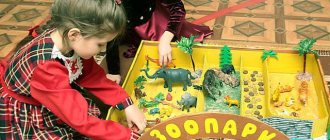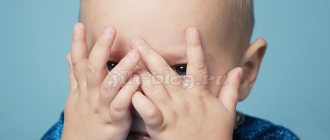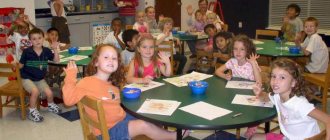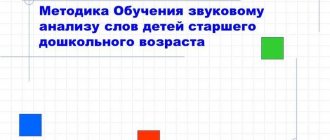Card index of games for the development of sound culture of speech (junior group)
Junior group
Goals: to develop phonemic hearing, speech attention, speech breathing, to consolidate the correct pronunciation of sounds and words.
Exercise “Blow on the fluff”
Children stand in a circle, the teacher gives them fluff. He suggests blowing on them, saying “Foo-oo-oo,” and watching them fly. Then the children pick up the fallen fluffs. (repeat 5-6 times.)
Material. For each child, a piece of fluff or a rectangle cut out of tissue paper (3x1 cm).
Game "Bear cubs eat honey"
The teacher tells the children that they will be bear cubs, and bear cubs really love honey. He suggests bringing your palm closer to your mouth (with your fingers away from you) and “licking” the honey - the children stick out their tongues and, without touching their palm, imitate that they are eating honey. Then, lifting the tip of the tongue, remove it. (Mandatory demonstration of all actions by the teacher.)
The game is repeated 3-4 times.
Then the teacher says: “The bear cubs are full. They lick their upper lip (show, lower lip {show). They stroke their bellies, saying: “U-oo-oo” (2-3 times)
Game "Let's feed the chicks"
Educator. I am a mother bird, and you are my baby birds. The chicks are cheerful, they squeak: “Pi-pi-pi,” and flap their wings (children repeat the movements after the teacher and pronounce the sound combination).
— The mother bird flew off to get tasty crumbs for her children, and the chicks flew merrily and squeaked. ({Children say: “Pee-pee-pee.”)
— Mom flew in and started feeding her babies {the children crouch down, raise their heads up, the chicks open their beaks wide, they want tasty crumbs {the teacher imitates feeding the chicks, getting the children to open their mouths wider). The mother fed everyone and flew away, and the chicks again fly and squeak. The game is repeated 2-3 times.
Game "Clock"
Educator. Listen to how the clock ticks: “Tick-tock, tick-tock”, how the clock strikes: “Bom-bom.” In order for them to walk, you need to start them: “Trick-Trac.” Let's wind up a big clock (children repeat the corresponding sound combination 3 times); Our clock goes and first ticks, then strikes (sound combinations are repeated by the children 5-6 times). Now let's wind up the small clock, the clock goes and sings quietly, the clock strikes very quietly (the children imitate the ticking and ringing of the clock with their voices each time).
Game “Hit a nail with a hammer”
Educator. When a large hammer knocks, you can hear: “Knock-knock-knock” (children repeat the sound combination 5-6 times). When a small hammer knocks, you can hear: “Bale-buck-buck” {children repeat the sound combination 5-6 times).
Let's hammer the nail in with a big hammer.
Now let's hammer in a small nail with a small hammer.
Close your eyes and listen to which hammer is knocking (without a system, the teacher repeats sound combinations 4-5 times, and the children say which hammer is knocking).
Exercise “At the doctor’s appointment”
Educator. The doll is a doctor. The doctor came to see if any of the children had a sore throat. Whoever the doctor approaches, let him open his mouth wide (children do).
The doctor said that all the children were healthy and no one had a sore throat.
Let's check your teeth, let the doctor see if they hurt you. {Children, together with the teacher, move their tongues over their teeth in a circular motion with their mouths closed and open.)
Whoever the doctor approaches will show his teeth (teeth closed).
The doctor said that everyone’s teeth are healthy.
Material. Toy hare; pictures of a bear, squirrel, elephant, monkey, bird, dog on flannel; flannelograph; one cotton ball for each child; There are two cubes on each table.
Exercise “Kick the ball into the goal”
On each table - on the edge opposite from the children - two cubes (gates) are placed at a distance of 10 cm from each other. Children blow on cotton balls to hit the goal.
Game "Be careful"
Educator. I have different pictures. If I show you a picture of an animal, you must scream as it screams and raise the blue circle. If I show you a toy, you will raise a red circle and name the toy.
The teacher shows pictures (at random, and the children
perform actions.
Exercise “Freeze your hand”
Children bring their hand to their mouth at a distance of about 10 cm and say:
“Foo-oo-oo” - they blow on the hand. Repeat the exercise 4-5 times.
Exercise "Pendulum"
The teacher says that some clocks have a pendulum. It swings (show, and the clock moves. If the pendulum stops, the clock will stand. Our tongues will be pendulums. Open your mouth wider. The tongue will “walk between your teeth (show) Repeat the exercise 3 times. After a short break, do it again.
Game "Guess the word"
Teacher (puts out pictures of animals on a flannelgraph according to the number of children in the group). I will begin to name the animal, and the one I ask will name it correctly. I will say: “Losha. ", and you should say: "Horse" or "horse".
The teacher pronounces the word without the last syllable or sound, the children name the whole word.
Material. Toys: doll, bunny, pyramid, car.
Game “Teach the bear to speak correctly”
Educator. Mishka told me that he doesn’t know how to name toys correctly and asks me to teach him. Let's help him. Bear, what is the name of this toy (shows the doll? (Bear. Doll.) No, wrong. This. (children call the toy in unison). Tell, Lena (names are introduced for ease of presentation, what is the name of this toy. Say, Vova, louder. Bear, now you say it correctly. Well done, you named it correctly. What is the name of this toy, bear (shows the bunny? (Bear. Zak.) Say, Kolya, correctly. (Answer.) Now everyone repeat the word. Bear, now you say it. Similar work carried out with the names of other toys: pyramid (piradka, car (shimina). Material. Toys: doll, bunny, pyramid, car.
Game "Bells Are Ringing"
Educator. The big bell (shows a big circle) rings: “Ding, ding, ding.” The little one (shows a small circle) rings: “Ding, ding, ding” (children repeat the sound combinations). When I show the big circle, the big bells will ring; when I show a small circle, small bells will ring.
The teacher shows either large (3 times) or small (3 times) circles (haphazardly).
Material. Large and small mugs of any color.
Game "Horses and Train"
(in a circle) Teacher. When the horses gallop, you can hear: “Tsok, Tsok, Tsok” (children repeat the sound combination); when the train is moving, the wheels knock: “Chok, chok, chok” (children repeat). The horses galloped. The horses are resting. The train started moving and the wheels rattled. The train stopped. The game is repeated 3 times.
Tasks of the ZKR in the second younger group: The formation of sound pronunciation is carried out in three stages:
Transcript
1 The tasks of the ZKR in the second younger group: 1. Continue to teach how to clearly pronounce vowels and some consonants: A, U, I, O, E, P, B, T, etc. Development of the speech motor analyzer. Introduce children to the parts of the articulatory apparatus (lips, teeth, tongue) and their movements. 2. Develop speech hearing, if auditory attention is sufficiently developed (learn to correlate sound with an object and place of sound delivery). 3. Develop speech breathing (aimed at the ability to pronounce a phrase of 3-4 words on one exhalation), if the oral exhalation is sufficiently developed (with a sufficiently strong, smooth oral exhalation). 4. Develop tempo, rhythm, strength and pitch of voice, intonation expressiveness. (see “Program for the education and training of children in kindergarten in the second junior group,” ed. by M.A. Vasilyeva, V.V. Gerbova et al., p. 17). The formation of sound pronunciation is carried out in three stages: Preparation of the articulatory apparatus, clarification of the pronunciation of sound in isolation by imitation, consolidation of the sound in words, phrasal speech. Each stage of the lesson is conducted separately with an interval of 3-6 days (V.V. Gerbova. Classes on speech development in the second junior group of kindergarten. Lesson plans. Ed. M.A. Vasilyeva, T.S. Komarova p. 11). In the process of work, it is important to take into account that for the correct sound “S” (slit and anterior lingual) the reference ones are “F”, “I”, therefore it is necessary to clarify the pronunciation of simple sounds (slit, anterior lingual). For the sound “L” (sonorant) the reference is “T” (at the place of formation), “Y” (raising the tongue to the palate).
2 December November October September V A A U A,U V O VV I E M M P P B B Development of auditory attention and memory. Sounds around us (sounds of the surroundings of action: nature, everyday life). Sounds around us - sounds (of the surrounding reality of nature, everyday life) Sounds that animals make. Sounds of the street (transport). Introduction to the parts of the articulatory apparatus. Development of physiological breathing (oral exhalation). Development of speech breathing and voice. Develop the ability to highlight the sound in a word with a voice and pronounce it drawlingly. Controlling the doll Anya. Story game "Locomotive". Development of speech breathing. Develop the ability to pronounce phrases at a normal pace. Teach children to pronounce several identical syllables on one exhalation (mumu-2 syllables) Teach children to pronounce plosive sounds clearly and briefly (P, B, K, G, T, D). Learn to pronounce several identical syllables on one exhalation (bibi-bi; 3;4;5)
3 May April March February January T T V D D K K V G G T,P,K F V F V V C V S Z Z C V C Sounding Development of speech toys, breathing and voice. musical To develop the ability to use instruments, pronounce phrases in everyday objects. at different paces. (1). Sounding Teach clearly, toys, music to correctly pronounce instruments, sounds, sound signatures. Houseware. The same (1-2) Preparation of the speech apparatus for the pronunciation of whistling and hissing sounds. The same (1-2) Practice clear pronunciation of the sound “C”. Sounding toys, musical instruments (2-4) Consolidate developed skills. Learn to change the pace of speech.
4 Tasks of the ZKR in the middle group: 1. Continue to teach how to clearly pronounce vowels and some consonants: A, U, I, O, E, P, B, T, etc. Development of the speech motor analyzer. Continue to introduce children to the parts of the articulatory apparatus (lips, teeth, tongue, palate) and their movements. Practicing the basic movements of the articulatory apparatus. 2. Develop phonemic hearing, if auditory attention is sufficiently developed (learn to correlate sound with an object and the place where the sound is presented). Learn to name words that begin with a certain sound. 3. Develop speech breathing (aimed at the ability to pronounce a phrase of 4-5 words on one exhalation), if the oral exhalation is sufficiently developed (with a sufficiently strong, smooth oral exhalation). 4. Continue working on diction: improve clear pronunciation of words and phrases. Improve intonation expressiveness of speech (tempo, rhythm, strength and pitch of voice) “Program for raising and teaching children in kindergarten in the middle group. Ed. M. A Vasilyeva, V.V. Gerbovaya, p.106. The formation of sound pronunciation is carried out in three stages: Preparation of the articulatory apparatus, clarification of sound pronunciation, consolidation of sound in words, phrasal speech. Each stage of the lesson is conducted separately with an interval of 3-6 days. In the process of work, it is important to take into account that for the correct sound “S” (slit and anterior lingual) the reference ones are “F”, “I”, therefore it is necessary to clarify the pronunciation of simple sounds (slit,
5 anterior lingual). For the sound “L” (sonorant) the reference is “T” (at the place of formation), “Y” (raising the tongue to the palate). A child with well-developed phonemic hearing is able to: Recognize sound in a speech stream (sounds, syllables, words). Distinguish between words consisting of the same sounds arranged in a certain sequence Understand the meaning of paronymous words.
6 December November October September A U V A-U O E I V Y V V V Y-I N T D K G X K, G, X Develop auditory attention and memory. Sounds around us (musical instruments, sounds of surrounding activities: knocking, rustling) Development of speech hearing. Learn to distinguish the sounds “Y-I” by ear and sound. Teach children to determine the tempo of speech by ear and perform movements at the appropriate pace. Learn to distinguish by ear and the sounds “K-G-H” Continue familiarization with the parts of the articulatory apparatus (palate, tip of the tongue), with their movements. Introduce the concepts of “word” and “sound”. Development of speech breathing and voice strength. Develop the ability to highlight the sound in a word with a voice and pronounce it drawlingly. Learn to change the strength of your voice from quiet to loud and vice versa on one exhalation. Develop the ability to pronounce phrases at a normal pace. Develop the skill of pronouncing phrases (of 3-5 words) with the intonation of a story or a question. Clarify the position and movements of the tongue necessary for the correct pronunciation of sounds.
7 May April March February January VV F V S Z C T Learn to isolate a certain sound from a stream of words. Learn to distinguish by ear and in pronunciation the sounds “F-V” Learn to distinguish by ear and in the sounds “S-Z-C” Develop the skill of clear and correct pronunciation of sound in syllables, words and phrasal speech. Develop the ability to pronounce a phrase of 4-5 words in one exhalation VVV Ш Ш Ж Ж Ч ШЧ ШЛЛЛЛР Learn to distinguish by ear and the sounds “SH-Zh” Learn to select objects whose names have a certain sound. Strengthen the skill of distinguishing by ear and speech sounds. Develop the skill of clear and correct pronunciation of sounds. Learn to change the pace of speech (from slow to fast). Strengthen the ability to pronounce a phrase of 4-5 words on one exhalation
8 Tasks of the ZKR in the first junior group: 1. Continue to teach how to clearly pronounce vowels and some consonants: A, U, I, O, E, P, B, T, etc. Development of the speech motor analyzer. Introduce children to the parts of the articulatory apparatus (lips, teeth, tongue) and their movements. 2. Develop speech hearing, if auditory attention is sufficiently developed (learn to correlate sound with an object and place of sound delivery). 3. Develop speech breathing (aimed at the ability to pronounce a phrase of 3-4 words on one exhalation), if the oral exhalation is sufficiently developed (with a sufficiently strong, smooth oral exhalation). 4. Develop tempo, rhythm, strength and pitch of voice, intonation expressiveness. (see “Program of education and training of children in kindergarten in the second junior group”, ed. by M.A. Vasilyeva, V.V. Gerbova, etc., p. 17) The formation of sound pronunciation is carried out in three stages: Preparation of the articulatory apparatus, clarification of sound pronunciation in isolation by imitation, consolidation of sound in words, phrasal speech. Each stage of the lesson is conducted separately with an interval of 3-6 days (V.V. Gerbova. Classes on speech development in the first junior group of kindergarten. Lesson plans. Ed. M.A. Vasilyeva, T.S. Komarova p. 11). In the process of work, it is important to take into account that for the correct sound “S” (slit and anterior lingual) the reference ones are “F”, “I”, therefore it is necessary to clarify the pronunciation of simple sounds (slit, anterior lingual). For the sound “L” (sonorant), the reference is “T” (at the place of formation), “Y” (raising the tongue to the palate).
9 Formation of speech understanding skills. Throughout the year, classes and didactic games are held weekly to develop the pronunciation side of speech, auditory attention and speech hearing, physiological and speech breathing. To develop the ability to use imitation of the height and strength of the voice (“Pussy, scat!”, “Who came?”). Learn to repeat after an adult a word and a small sentence, including one containing a question and an exclamation. Practice clearly pronouncing isolated vowels and consonants (except S, Z, Ts, Sh, Zh, Shch, Ch, R, L). September October November December January A U I O P B February March April May M T D V F Consolidation of developed skills.





